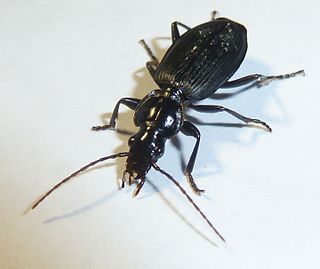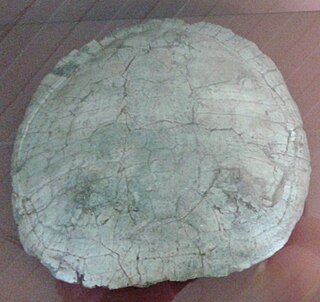
Caenorhabditis elegans is a free-living transparent nematode about 1 mm in length that lives in temperate soil environments. It is the type species of its genus. The name is a blend of the Greek caeno- (recent), rhabditis (rod-like) and Latin elegans (elegant). In 1900, Maupas initially named it Rhabditides elegans. Osche placed it in the subgenus Caenorhabditis in 1952, and in 1955, Dougherty raised Caenorhabditis to the status of genus.

Cymindis is a genus of ground beetle native to the Palearctic, the Near East, and North Africa. It contains the following species:

Hystrichopus is a genus of inconspicuous, nocturnal beetles in the family Carabidae. The genus is native to the greater part of the Afrotropics and locally to the southern Palaearctic.
Cymindis asiabadensis is a species of ground beetle in the subfamily Harpalinae. It was described by Jedlicka in 1961.

Cymindis axillaris is a species of ground beetle in the subfamily Harpalinae. It was described by Johan Christian Fabricius in 1794.

Cymindis cincta is a species of ground beetle in the subfamily Harpalinae. It was described by Brulle in 1839.
Cymindis cribricollis is a species of ground beetle in the subfamily Harpalinae. It was described by Pierre François Marie Auguste Dejean in 1831.
Cymindis dostojewskii is a species of ground beetle in the subfamily Harpalinae. It was described by Tschitscherine in 1896.
Cymindis ehlersi is a species of ground beetle in the subfamily Harpalinae. It was described by Jules Putzeys in 1872.
Cymindis lateralis is a species of ground beetle in the subfamily Harpalinae. It was described by Fischer Von Waldheim in 1820.
Cymindis scapularis is a species of ground beetle in the subfamily Harpalinae. It was described by Schaum in 1857.
Cymindis simplex is a species of ground beetle in the subfamily Harpalinae. It was described by Zoubkoff in 1833.
Cymindis singularis is a species of ground beetle in the subfamily Harpalinae. It was described by Rosenhauer in 1856.
Cymindis triangularis is a species of ground beetle in the subfamily Harpalinae. It was described by Reitter in 1897.
Cymindis uyguricus is a species of ground beetle in the subfamily Harpalinae. It was described by B. Gueorguiev in 2000.

Cymindis vaporariorum is a species of ground beetle in the subfamily Harpalinae. It was described by Carl Linnaeus in 1758. Most adults are collected in June and July, but likely are around all summer.
Cymindis vartianorum is a species of ground beetle in the subfamily Harpalinae. It was described by Mandl in 1973.
Cymindis velata is a species of ground beetle in the subfamily Harpalinae. It was described by Thomas Vernon Wollaston in 1865.
C. elegans most commonly refers to the model round worm Caenorhabditis elegans. It may also refer to any of the species below. They are listed, first in taxonomic order and, second, alphabetically.

Bauruemys is an extinct genus of turtles in the family Podocnemididae.






